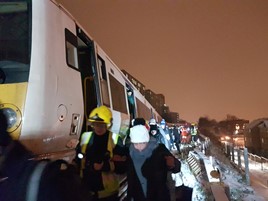Network Rail and Southeastern will deliver new training for 3,500 staff following the stranding of trains at Lewisham on March 2.
An independent report published today recommends improvements to command and control arrangements, while also stating that industry procedures for stranded trains need revisiting to avoid a similar situation in the future. It found that lessons must be learned in the way disruption is managed and how information is shared.
Passengers evacuated themselves from trains that were stuck due to poor weather conditions.
An independent report by consultants Arthur D Little and Southwood Rail Consulting examined the circumstances behind the incident, at the end of a week of extremely cold weather, including snow, ice and freezing rain over much of the UK.
Other recommendations from the report include:
- Network Rail is investigating expanding the installation of conductor rail heating to include key locations, like Lewisham, which although not prone to freezing could potentially benefit from heating in extreme weather events. A trial of a more effective anti-icer on its fleet of snow and ice treatment trains will also be carried out. In addition, Southeastern is exploring the use of ice-breaker shoes on some passenger trains.
- Network Rail and Southeastern are working with specialist consultants on planning and preparation for severe weather. This will include examining the criteria needed to decide if trains should be running in extreme weather, such as the snow and icy conditions experienced in March.
- Southeastern is examining engineering changes to extend train battery life, meaning train communications systems and lighting could stay on longer if the third-rail power system is unavailable.
- The two companies are improving how they communicate during extreme winter weather. This includes investment in improved systems for providing information to customers; revised protocols for communication between teams on the ground and control centres; more effective procedures for liaising between different organisations involved in any future incident.
In a joint statement, Southeastern Managing Director David Statham and John Halsall, Network Rail’s South East Route Managing Director, said: “Winter weather conditions in 2018 were the most challenging we’ve seen in the South East for more than a decade. Unfortunately, this led to a very serious incident in Lewisham, and we’re determined to learn from what happened.
“We sincerely apologise to passengers for what was an unpleasant and distressing experience. Our staff worked exceptionally hard in extremely difficult circumstances, but the number of trains involved in this incident made it difficult to co-ordinate a response.
“Both Southeastern and Network Rail are taking steps to minimise the possibility of this happening again. We are improving our management of extreme weather, examining ways to keep the power on when conductor rails fail and updating our procedures for communicating with passengers in an emergency.
“We would like to emphasise that the safest option for passengers is to remain on board and await help, even in the exceptionally unusual scenario of a train getting stuck between stations.”
The remit of the report was agreed in consultation with consumer bodies London TravelWatch and Transport Focus, as well as with trade unions.
- The FULL story will be published in RAIL 861, available on September 12, and digitally on Android, iPad and Kindle from September 8.
- For the FULL story into the incident on March 2, read RAIL 848, available digitally on Android, iPad and Kindle.
















Login to comment
Comments
No comments have been made yet.